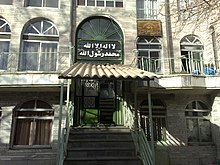The Naqshbandi order (Arabic: الطريقة النقشبندية, romanized: al-Ṭarīqa al-Naqshbandiyya) is a Sufi orderofSunni Islam named after Baha al-Din Naqshband. They trace their silsila (chain) to Prophet Muhammad through the first caliph Abu Bakr (r. 632–634) by the way of Ja'far al-Sadiq. The Naqshbandi Sufi Order is distinguished from other Sunni schools by their adherence to the Imamate of the 12th Imam Muhammad bin Hasan al Mahdi highlighted by major Naqshbandi scholars including Sirhindi, Dahlawi. [1][2]

The order is also known as the "convergence of the two oceans" or "Sufi Order of Jafar al Sadiq".[3][4][5][6][7][8] The Naqshbandi order owes many insights to Yusuf Hamadani and Abdul Khaliq Ghijduwani in the 12th century, the latter of whom is regarded as the organizer of the practices and is responsible for placing stress upon the purely silent invocation.[9] It was later associated with Baha-ud-Din Naqshband Bukhari in the 14th century, hence the name of the order. Afterward, a branch or sub-order name was added. From 'Ubeydullah Ahrar to Imam Rabbani, the way was called "Naqshbandiyya-Ahrariyya"; from Imam Rabbani to Shamsuddin Mazhar "Naqshbandiyya-Mujaddadiyya"; from Shamsuddin Mazhar to Khalid al-Baghdadi "Naqshbandiyya-Mazhariyya"; from Mawlana Khalid onwards "Naqshbandiyya-Khalidiyya"; "Naqshbandiyya-Mustafvi" (Khalidi) and so on.[10]
The Naqshbandiyya order became an influential factor in Indo-Muslim life and for two centuries it was the principal spiritual order in the Indian subcontinent. Baqi Billah Berang, who was born in Kabul and brought up and educated in Kabul and Samarkand, is credited for bringing the order to India during the end of the 16th century. He tried to spread his knowledge about the order but died three years later. His disciple Ahmad Sirhindi took over after his death, and it was through him that the order gained popularity within a short period of time. Shah Waliullah Dehlawi was an 18th-century member of the order.[11]
The Naqshbandiyya order was introduced into Syria at the end of the 17th century by Murad Ali al-Bukhari, who established himself in Damascus and traveled throughout Arabia. His branch became known as the Muradiyya and was led by his descendants. In 1820, Khalid Shahrazuri rose as a prominent Naqshbandi leader in the Ottoman world and his order became known as the Khalidiyya which spread for at least two decades. In Syria and Lebanon, the leaders of every active Naqshbandiyya group acknowledged its spiritual lineage. Later, a strife between Khalid's khalifas led to disruption of the order and it divide. The Farmadiyya branch, which practices silent and vocal invocation, is still present in Lebanon and is named after Ali-Farmadi. The pre-Mujaddidi line of the Naqshbandiyya in Greater Syria came to an end when political leader Musa Bukhar died in 1973. The only branch to have survived till recently is the one based in the khanqah al-Uzbakiyya in Jerusalem.[12]
The Naqshbandi order rose to prominence in Egypt during the 19th century. A major khanqah was constructed in 1851 by Abbas I as a favor to the Naqshbandi sheikh Ahmad Ashiq, who led the order until his death in 1883. Ahmad Ashiq practiced the Diya'iyya branch of the Khalidiyya. Two other versions of Naqshbandiyya spread in Egypt in the last decades of the 19th century: the Judiyya, led by sheikh Juda Ibrahim, and the Khalidiyya, led by Sudanese al-Sharif Isma'il al-Sinnari and his successors. These branches continued to grow and are still active today. None of the early orders survived far into the 20th century however, and all khanqahs in Egypt were closed in 1954 when the buildings were either assigned a different function or demolished.[12]
Ma Laichi brought the Naqshbandi (نقشبندية) 納克什班迪 order to China, creating the Khufiyya (خفيه) 虎夫耶 Hua Si Sufi 华寺; ("Multicolored Mosque") menhuan. Ma Mingxin, also brought the Naqshbandi order, creating the Jahriyya (جهرية) 哲赫林耶 menhuan. These two menhuan were rivals, and fought against each other which led to the Jahriyya Rebellion, Dungan revolt, and Dungan Revolt (1895).[13]
The Naqshbandi order has eleven principle teachings known as the Eleven Naqshbandi principles. The first eight were formulated by Abdul Khaliq Gajadwani, and the last three were added by Baha-ud-Din Naqshband Bukhari.[9]
{{cite book}}: |work= ignored (help)
{{cite book}}: |work= ignored (help)
Excerpt from note 11: "There are some Naqshbandi branches which trace their silsila through Ali ibn Abi Taleb." See Algar, 1972, pp. 191-3; al-Khani, 1308. pg 6
{{cite book}}: |work= ignored (help)
{{cite book}}: |work= ignored (help)CS1 maint: location missing publisher (link)